Abstract
In order to break the bottleneck in the teaching and research of superconducting current limiting technology, this paper proposed an integrated platform based on a resistive-type superconducting current limiter (RSFCL). Through a user-programmable software interface, the dynamic working process of the RSFCL was simulated and analyzed, along with the self-triggered quench characteristics, internal current distribution, and instantaneous temperature evolution process under different fault conditions. This platform employed a superconductor–circuit–temperature coupling model to simulate the current limiting characteristics of the RSFCL under various AC/DC and transient conditions. This effectively helps the users understand the electrothermal coupling mechanisms of the RSFCL but also provides the researchers with an efficient simulation tool to analyze superconducting properties, optimize fault current limiter topologies, and validate system-level fault protection strategies. The platform’s simulation results align well with theoretical analyses, offering a reliable auxiliary tool for teaching and research in superconducting power technology.
1. Introduction
As distributed generation from renewable energy sources rapidly expands, levels of power fluctuations and short-circuit currents in power grids are steadily increasing [,,,]. Many traditional protection devices, such as series reactors and fuses, suffer from serious drawbacks such as high costs, significant power losses, insufficient adaptability to complex load conditions, and absence of automatic reset functionality, allowing them to meet the rapid protection requirements [,].
Resistive-type superconducting fault current limiters (RSFCLs) have emerged as an effective solution [,], offering advantages such as rapid response and automatic recovery [,]. RSFCLs primarily leverage the inherent properties of the material to achieve a reasonable transition between the superconducting state and the normal state, enabling real-time protection and current control following a circuit fault [,,,,,]. Their operational process involves a complex electrothermal multi-physics coupling [,].
Currently, the main RSFCL modeling methods primarily rely on finite element analysis technology [,,,,]. This method can accurately simulate the resistive characteristics of each layer of the conductor and support thermal field coupling to establish an electrothermal interaction model [,,,]. However, the finite element method has the limitation of slow computational speed, making it difficult to meet the requirements of real-time operation [,]. Additionally, the modeling process is relatively complex, making it unsuitable for rapid research during the engineering application and posing a significant barrier to use by non-specialist researchers out of the superconductivity field.
To improve computational efficiency and enhance the modeling adaptability, many academic papers and reports have also established equivalent circuit models based on numerical and electrical simulation software like MATLAB [,] and PSCAD [,]. Most research employs the E-J theorem to model the SFCL as an ideal variable resistor [,,], neglecting real-time temperature variations during current limiting operations [,]. Some studies incorporate temperature change modules [,], considering fixed thermal conductivity [,] and heat capacity parameters [,] or employing an ideal heat transfer formula [,,], yet they fail to account for the dynamic variations under liquid nitrogen boiling conditions.
To address these technical limitations, this study developed a circuit–temperature coupled research and teaching platform for the RSFCL, which integrated superconductors, circuits, and temperature into an all-in-one software. Through experimental data fitting, formulas for thermal conductivity and heat capacity parameters under varying temperatures and temperature differentials were derived. These were integrated into the E-J theorem to form a current–temperature resistance coupled model for analyzing the dynamic current limiting and recovery processes of the SFCL. The platform established a multi-layer conductor model to visually demonstrate current redistribution during the transition between the superconducting state and the normal state. It incorporated a dynamic operating condition analyzer, retaining system-level fault simulation capabilities. It adopted a parameterized interface design, allowing for the rapid integration of new superconducting material parameters and topological structure parameters. With the platform, the users can conveniently study the influence of key parameters on current-limiting performance, providing a reliable research platform for the optimized design and application of current limiters. In terms of education, the platform can visually demonstrate the operating process through a GUI, effectively addressing issues such as safety and high operating costs, thereby aiding students in deeply understanding the working principles of fault current limiters.
2. Mathematical Model
To better reflect the authenticity of the model, this study selected commercially available coated superconducting tapes produced by Shanghai Superconductor Technology Co., Ltd. (Shanghai, China) as a reference. As shown in Figure 1a, the entire superconducting tape consists of multiple layers, primarily including a silver layer, a copper layer, a stainless-steel layer, a Hastelloy layer, and a superconducting layer. Among these, the Hastelloy layer features high resistivity and non-magnetic properties, with eddy current losses and ferromagnetic losses being nearly zero. At 300 K, its normal state resistance of the whole tape is approximately 70 mΩ/m. It should be noted that the stainless-steel layers on both sides of the superconducting tape were already encapsulated before the product was manufactured. The two layers of stainless-steel wrap around the internal superconducting coating and other materials to form a closed flat strip-like structure as a whole. The internal heat accumulation can be rapidly dissipated through the stainless-steel layers into the surrounding liquid nitrogen.

Figure 1.
Schematic diagrams of superconducting tape and bifilar pancake: (a) internal coating tape structure; (b) top view of bifilar pancake structure.
2.1. Superconductor Temperature Model
The relationship between the critical current and temperature is as follows []:
where Ic0 is the average critical current of the superconducting material, Tc is the critical temperature, and β is the temperature exponent.
According to the non-linear power law [], the equations for calculating the resistance of a superconductor are as follows:
where L is the length of the tape, Ec is the critical field strength, Us and Is, respectively, represent the voltage and current of the superconducting layer, and n is the magnetic field exponent.
2.2. Normal Conductor Temperature Model
The resistance calculating equations of silver, copper, and stainless-steel layer are as follows [,]:
where KAg, KCu, and KSS are the resistivity temperature coefficients of silver, copper, and stainless-steel, respectively; SAg, SCu, and SSS are the cross-sectional areas of the silver, copper, and stainless-steel layers, respectively; and L is the length of the tape. Note that 0.27, 0.19, and 56.8 are the resistivity of silver, copper, and stainless-steel at 77 K, in units of 10−8 Ω·m.
2.3. Temperature Calculation Model
The temperature calculation is based on the energy conservation equation. The superconducting coil is installed in a low-temperature medium (such as liquid nitrogen). During superconducting quench, the heat generated inside the superconducting tape mainly flows into the low-temperature medium through the stainless-steel layer [,]. The heat released by the superconducting coil is obtained by integrating the product of current and voltage from t1 to t2 in the RSFCL, then subtracting the heat absorbed by the cryogenic medium, resulting in the increase in heat at t2 compared to t1, which is expressed as follows:
where Us is the voltage across the RSFCL, Itotal is the total current flowing through the RSFCL, and Qout is the heat absorbed by the cryogenic medium per unit time.
The cooling power is calculated using a convective heat transfer model, as shown in
where h is the convective heat transfer coefficient of the stainless-steel, A is the heat transfer surface area, T is the surface temperature of the stainless-steel, and Tf is the temperature of the cryogenic medium.
The temperature difference between the stainless-steel surface and the cryogenic medium is expressed as follows:
The equation for calculating the convective heat transfer coefficient h of stainless-steel is as follows [,]:
which can be fitted by the user according to the actual data.
The temperature difference ΔT between the superconducting coil at time t2 and time t1 is obtained by dividing the heat gain ∆Q by the product of the specific heat capacity cv and mass m of the superconducting coil. The expression for this temperature difference ΔT is as follows:
where the specific heat capacity cv of stainless-steel with respect to temperature T is expressed as follows [,]:
which can be fitted by the user according to the actual data. Note that both of the two heat transfer performance formulas for stainless-steel materials are empirical models, which can only be used for typical result verification. If users need to precisely analyze the heat conduction characteristics during the superconducting material’s quenching process, they need to conduct precise modeling based on the actual device operating conditions.
The temperature value is continuously updated with each time step. The temperature value at the next time step is obtained by adding the temperature difference between the two time steps to the temperature value at the previous time step.
2.4. Current Calculation Model
The superconductor is wrapped in three layers of silver, copper, and stainless-steel on the outside, which can be processed into four parallel resistors. Figure 2 shows the equivalent circuit model of the platform. The total current flowing through RSFCL during a fault can be expressed as follows:

Figure 2.
Equivalent circuit model.
2.5. System Principle
As shown in Figure 2, when a short circuit or overcurrent fault occurs in the circuit, the current Itotal flowing through the current limiter rapidly increases. When this current value exceeds the critical current Ic of the superconducting layer, the superconducting layer will no longer be in a zero-resistance state, and the resistance value of RSFCL will rapidly increase, thereby achieving the purpose of limiting the fault current. Meanwhile, the power supply voltage U is primarily distributed to the current limiter.
For the temperature calculation module, as the current and voltage flowing through the current limiter increase, the heat generated by the current limiter per unit time also significantly increases. The low-temperature medium can only absorb part of the heat, i.e., ΔQ > 0. Therefore, the temperature of the current limiter will continue to rise until the RSFCL returns to the superconducting state.
As shown in Figure 3, the changes in temperature will affect the operation of the four models mentioned earlier. The increase in temperature causes the critical current of the superconductor to decrease, thereby increasing the resistance of the superconducting layer. Simultaneously, the increase in temperature causes the resistance of the normal conductor to increase, further increasing the resistance of the current limiter, achieving better current limiting effects in the short term.
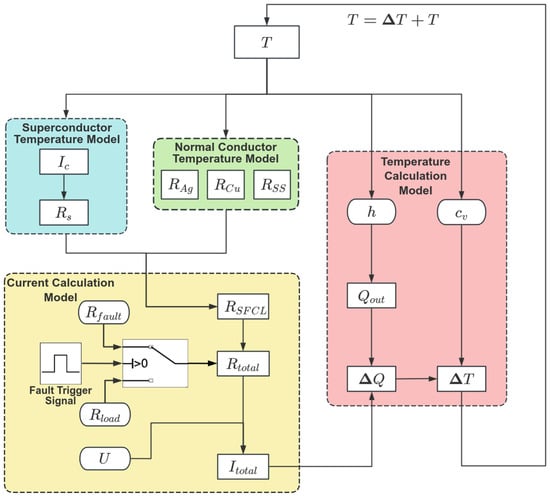
Figure 3.
Mathematical model and calculation process.
When the fault is cleared, as the total current rapidly decreases, the cooling effect of the low-temperature medium becomes dominant, and the temperature gradually returns to the initial operating temperature, ensuring the accuracy of the simulation for normal operation during the fault recovery.
According to the basic principles of circuits, a resistor in a circuit can be equivalently represented as a voltage drop. Then, according to the mathematical model in Figure 3, the SFCL can be equivalently regarded as a controllable voltage source. The specific modeling process is presented in Figure 4. First, input the real-time current of the circuit into the temperature calculation model; then, the obtained SFCL temperature data are further input into the superconductor temperature model and the normal conductor temperature model, respectively, to obtain the quenching resistance of the superconducting layer and the normal resistance of the metal multi-layers. By calculating the two resistances in parallel, the current-limiting resistance data of the entire SFCL is obtained. Finally, by multiplying the real-time circuit current data with the current-limiting resistance data, the output voltage of the equivalent voltage source of the SFCL can be obtained. The equivalent voltage source of SFCL obtained through the above modeling process can be directly embedded into various software platforms, such as MATLAB, PSCAD, etc. Electrical researchers in non-superconducting fields can use familiar controllable voltage sources to equivalently model the SFCL module and apply it to various AC/DC microgrid scenarios. It should be noted that the equivalent voltage source shown in Figure 4 is a single-line series voltage source, which can be directly applied to DC lines or single-phase AC line systems. If it is applied in three-phase AC lines, then a controllable voltage source module needs to be connected in series on each AC line.

Figure 4.
Equivalent controllable voltage source of the SFCL.
3. Platform Architecture Design
As shown in Figure 5, the platform interface is implemented through MATLAB software. The overall design is divided into three areas: parameter settings, result display, and result processing.
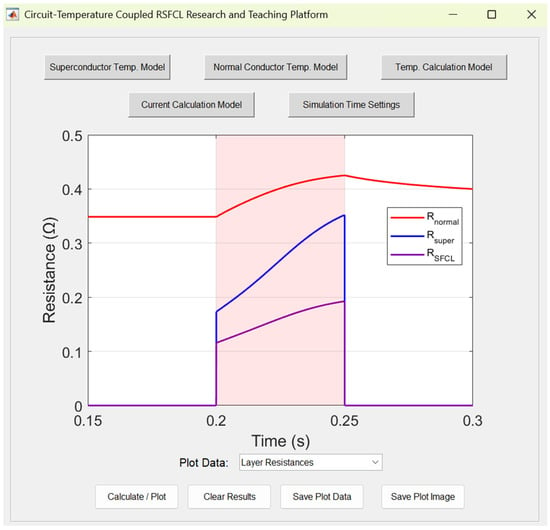
Figure 5.
Main Interface of the developed platform.
3.1. Parameter Settings Area
The main interface features five buttons, employing a modular design for parameter settings. Users can modify and save the system’s initial parameters according to actual needs. Each module also includes a “Reset” button to revert to the initial state.
3.1.1. Superconductor Temperature Model
The average critical current Ic0 is calculated by setting the initial critical current and initial operating temperature. The superconducting critical current can then be calculated by setting the critical temperature and temperature exponent. By setting the conductor length, critical field strength, and magnetic field exponent n, the resistance value of the superconducting layer can be changed, thereby affecting the current limiting capacity of the RSFCL.
3.1.2. Normal Conductor Temperature Model
By changing the cross-sectional areas and resistivity temperature coefficients of silver layer, copper layer, and stainless-steel layer, the real-time changes in the internal current distribution inside the RSFCL can be clearly observed.
3.1.3. Temperature Calculation Model
The temperature change process can be influenced by setting the heat transfer surface area, mass, stainless-steel-specific heat capacity, and convective heat transfer coefficient. Based on the specific requirements for superconducting application scenarios, the users can also choose to replace the existing model with a new one, import the actual operating parameter data, and implement more accurate and realistic current-limiting simulations.
3.1.4. Current Calculation Model
By setting the power supply voltage, load resistance, and fault resistance, the user can simulate the fault current limiting behaviors under different operating conditions. There also exist “Import Data” buttons, allowing users to import large amounts of real data to simulate the current limiting process.
3.1.5. Simulation Time Settings
By setting the total simulation duration, simulation step size, fault start time, fault end time, plot start time, and plot end time, the user can observe the actual operation of RSFCL under different fault conditions. When any input quantity in the Current Calculation Model is set to multiple data points, all input fields except the simulation step size will be disabled. The total simulation duration and plotting time are determined by the number of data points and the simulation step size, the fault occurs during the middle segment of the total simulation duration by default.
3.2. Result Display Area
The Result Display Area allows users to clearly plot the change curves of each resistor, current, and temperature throughout the entire time process by selecting the drawing objects in the drop-down menu under the drawing content. This clearly demonstrates the operational processes and results of the RSFCL.
3.3. Result Processing Area
The Result Processing Area includes four buttons: Calculate/Plot, Clear Results, Save Image Data, and Save Image. The “Calculate/Plot” button is used to initiate the simulation process and display simulation results when the parameter settings are completed; the “Clear Results” button is used to clear the canvas image; the “Save Image Data” button can save the numerical values corresponding to each point on the image curve as a MAT file, enabling the preservation of important simulation data; and the “Save Image” button can save the image for the visualized simulation results.
4. Simulation Verification and Analysis
The superconducting coil used in this simulation was wound in the bifilar pancake structure, as shown in Figure 1b. The tape is with an average tape width of 4.8 mm and an average thickness of 0.23 mm. The thicknesses of the sliver layer, copper layer, stainless-steel layer, Hastelloy layer, and superconductor layer are 3 μm, 10 μm, 160 μm, 50 μm, and 4 μm, respectively. In addition, in order to achieve sufficient insulation, the superconducting tape is insulated with approximately 0.1 mm thick adhesive tape, so the total thickness of the insulated superconducting tape used is approximately 0.43 mm. The low-temperature medium temperature is set to liquid nitrogen temperature (77 K). As shown in Table 1 and Table 2, these main parameters are obtained based on an actual superconducting current-limiting coil. The simulation parameters and performance indexes were compared and verified the consistency between the modeling and the experimental results in [].

Table 1.
GUI input: calculation parameters.

Table 2.
GUI input: tape parameters.
It should be noted that the core performance parameter data in the heat transfer formula were obtained through fitting based on the test results of the liquid nitrogen cooling experiments [,]. The formula for superconducting critical current and temperature resistance relation was also obtained through experimental tests using an actual SFCL coil in the laboratory []. That is to say, the model established in this paper and the relevant results obtained through simulation are in good agreement with the actual test results and possess relatively high accuracy and reliability.
Moreover, the SFCL simulation model established in this paper has excellent adaptability in various scenarios. If the user has his own more accurate or more suitable formulas and parameter data for the targeted application scenarios, then he can directly modify and adjust the formulas and parameters in the GUI shown in Figure 5, Figure 6, Figure 7, Figure 8, Figure 9 and Figure 10 and thereby conduct simulation analysis of the SFCL characteristics.
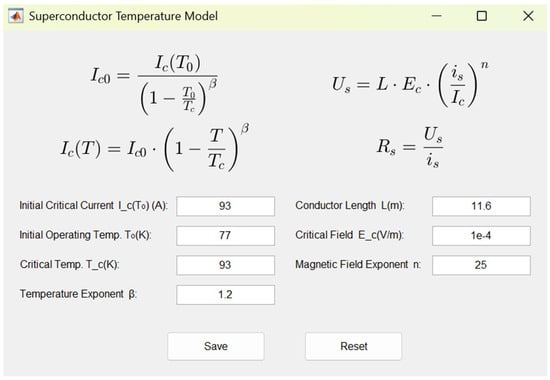
Figure 6.
Input parameter interface of the superconductor temperature model.
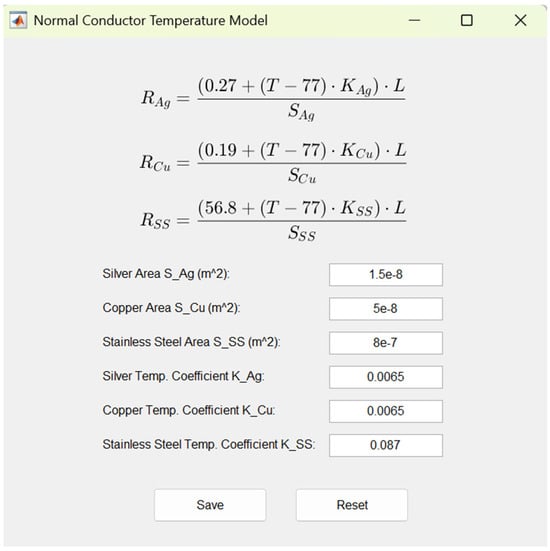
Figure 7.
Input parameter interface of the normal conductor temperature model.
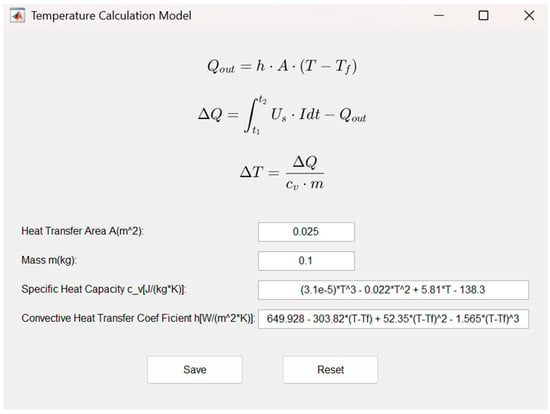
Figure 8.
Input parameter interface of the temperature calculation model.
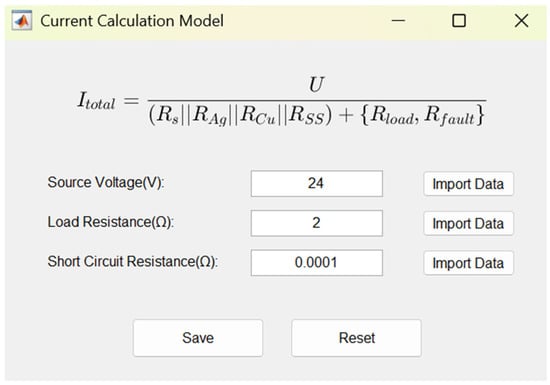
Figure 9.
Input parameter interface of the current calculation model.
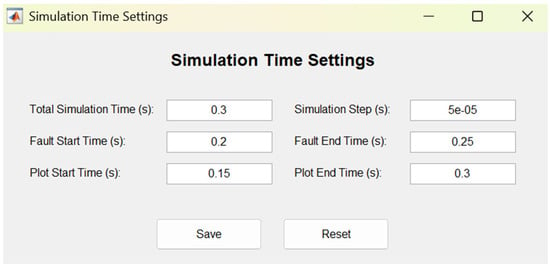
Figure 10.
Input parameter interface of the simulation time settings.
In this work, the simulation verification is divided into five scenarios: DC short circuit, AC short circuit, DC overcurrent, AC overcurrent, and transient disturbance. The focus will be on analyzing the working process under the DC short circuit scenario. The circuit settings for each scenario are as follows:
- (1)
- DC short circuit: The voltage source outputs a DC voltage of 24 V, and a short circuit fault occurs in the line between 0.2 s and 0.25 s. The simulation step size is 5 × 10−5 s.
- (2)
- AC short circuit: The voltage source outputs 24 V, 50 Hz AC voltage. A short circuit fault occurs on the line from 0.016 s to 0.034 s. The simulation step size is 5 × 10−5 s.
- (3)
- DC overcurrent: The voltage source outputs 24 V DC voltage. During the fault period, the load resistance is set to 0.15 Ω to simulate an overcurrent phenomenon on the line. The simulation step size is 5 × 10−5 s.
- (4)
- AC overcurrent: The voltage source outputs 24 V, 50 Hz AC voltage. During the fault period, the load resistance is set to 0.15 Ω to simulate an overcurrent condition on the line. The simulation step size is 5 × 10−5 s.
- (5)
- Transient disturbance: Based on a DC short circuit scenario, the voltage value and fault resistance value are set to randomly vary within a range of ±90% to simulate random disturbances. A short circuit fault occurs in the line from 0.16 s to 0.34 s, and the simulation step size is 5 × 10−4 s.
4.1. DC Short Circuit
Figure 11a shows the changes in the resistance of the superconductor and the normal conductor (silver layer, copper layer, stainless-steel layer) during a short-circuit fault in the simulation. At 0.2 s, the fault occurs, and the superconducting layer resistance rapidly increases from 0 Ω to 0.175 Ω then continues to increase at a gradually decreasing rate until the fault is restored at 0.25 s, reaching a peak value of 0.35 Ω, after which it rapidly decreases back to 0 Ω. The resistance of the normal conductor is linearly related to temperature and remains approximately constant during normal operation. During the fault, the resistance of the normal conductor increases from 0.35 Ω to 0.43 Ω, and after the fault is resolved, the resistance decreases slowly with temperature.
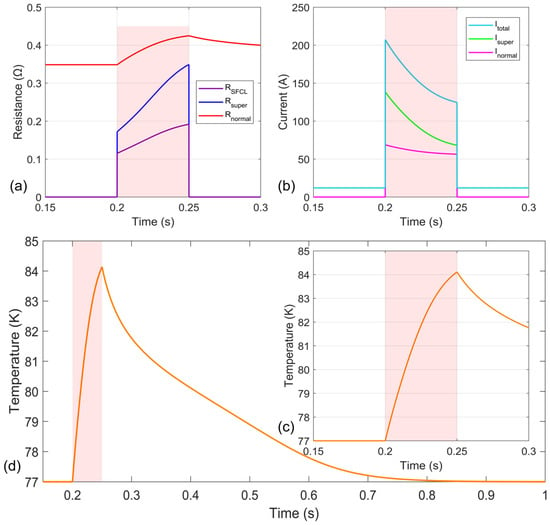
Figure 11.
Resistance, current, and temperature curves under DC short-circuit conditions: (a) resistance of each layer and total resistance of RSFCL; (b) current of each layer and total current of the line; (c) temperature rise process; (d) temperature drop process.
Figure 11b shows the distribution of the total current flowing through the RSFCL between the superconductor and the normal conductor during a short-circuit fault. During normal operation, the superconductor exhibits zero resistance, while the normal conductor has a certain resistance value, so almost all of the total current is distributed to the superconducting layer. During a short-circuit fault, the superconductor is in a quench state and its resistance value continues to increase, but its resistance value is still less than that of the normal conductor, so the superconducting layer bears most of the short-circuit current; the normal conductor layer also shares part of the short-circuit current to prevent excessive current in the superconducting layer.
Figure 11a,b also show the change curves of the total resistance and total current of the RSFCL, respectively. During normal operation, the current limiter resistance is close to 0 Ω, equivalent to a wire connected in series with the circuit. At 0.203 s, the total resistance increases to 0.12 Ω, limiting the fault current to 207 A. During a short-circuit fault, both the superconducting resistance and the resistance of other material layers increase continuously with rising temperature, causing the total current to decrease steadily, with the trend gradually flattening. At 0.25 s, the total resistance increases to 0.19 Ω, and the fault current decreases to 125 A.
Figure 11c shows the temperature change curve of the RSFCL during a fault. When a short-circuit fault occurs, the coil temperature rises sharply within 0.2 s to 0.25 s. At this point, the temperature change is primarily caused by the power increase in the RSFCL; however, due to the limitation of the fault current, the rate of temperature rise gradually slows down after the fault. At 0.25 s, the load resistance returns to its normal value, and the coil temperature reaches its peak of 84 K. After 0.25 s, the temperature changes in the coil are primarily caused by convective heat transfer from liquid nitrogen. When the temperature difference between the superconducting coil and liquid nitrogen is large, the temperature decreases rapidly; when the temperature difference is small, the temperature decrease is more gradual. At 0.85 s, the coil temperature drops to 77 K, as shown in Figure 11d.
4.2. AC Short Circuit
Figure 12 shows the resistance curve, current curve, and temperature curve under this condition. During the short circuit, the peak resistance of the superconducting layer reaches 0.18 Ω, and the resistance of the conventional conductor rises to 0.37 Ω, limiting the short circuit current to 197 A, with the current distribution shown in the figure. The operating temperature gradually increases from 77 K to 78.85 K, and returns to 77 K at 0.45 s.
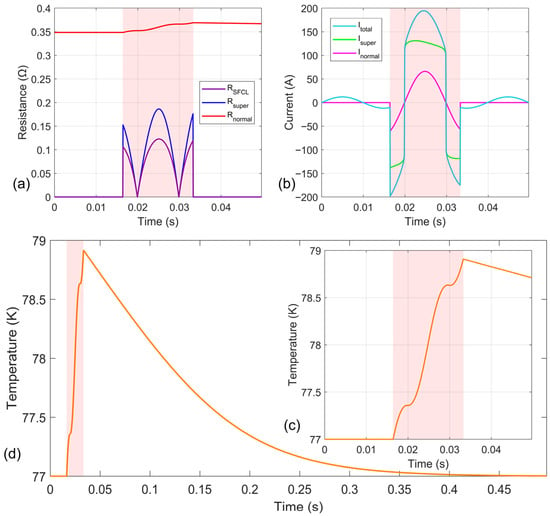
Figure 12.
Resistance, current, and temperature curves under AC short-circuit conditions: (a) resistance of each layer and total resistance of RSFCL; (b) current of each layer and total current of the line; (c) temperature rise process; (d) temperature drop process.
4.3. DC Overcurrent
Figure 13 shows the resistance curve, current curve, and temperature curve under this condition. During the overcurrent period, the RSFCL exhibited a resistance value of 0.03 Ω, limiting the current peak from 160 A to 138 A, effectively reducing the overcurrent by 13%. The operating temperature continues to rise to 78 K then falls back to 77 K at 0.6 s.
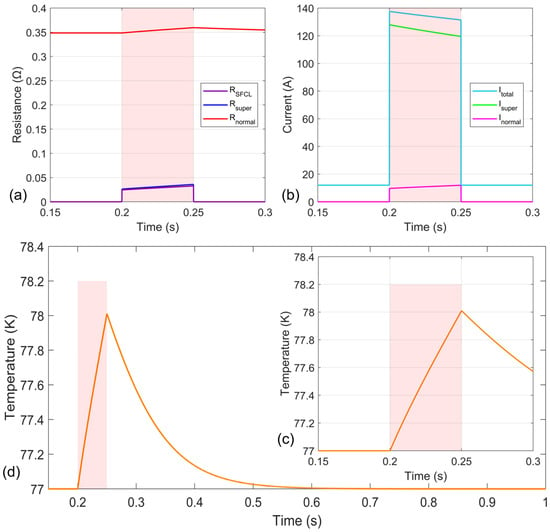
Figure 13.
Resistance, current, and temperature curves under DC overcurrent conditions: (a) resistance of each layer and total resistance of RSFCL; (b) current of each layer and total current of the line; (c) temperature rise process; (d) temperature drop process.
4.4. AC Overcurrent
As shown in Figure 14, the RSFCL exhibits a resistance value of 0.025 Ω during the overcurrent condition, limiting the current peak from 160 A to 138 A, effectively reducing the overcurrent by 13%. The peak temperature change is 77.074 K, returning to 77 K at 0.38 s.
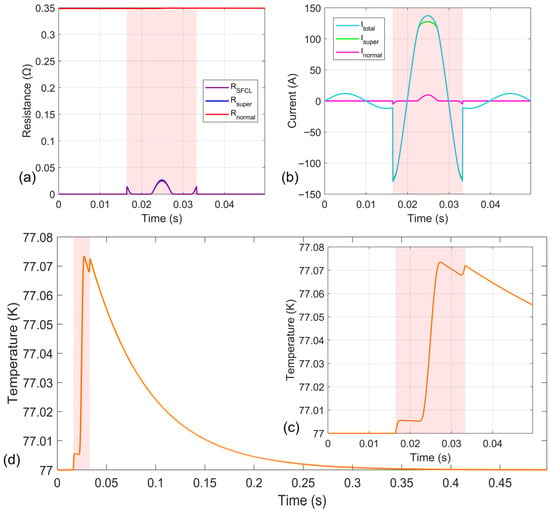
Figure 14.
Resistance, current, and temperature curves under AC overcurrent conditions: (a) resistance of each layer and total resistance of RSFCL; (b) current of each layer and total current of the line; (c) temperature rise process; (d) temperature drop process.
4.5. Transient Disturbance
As shown in Figure 15, under transient disturbance, the maximum resistance of RSFCL is 0.42 Ω, limiting the current peak to 255.6 A. This still exhibits a good current limiting capability even under ±90% large disturbance conditions. The temperature change peak is 90.57 K, recovering to 77 K at 5.67 s.
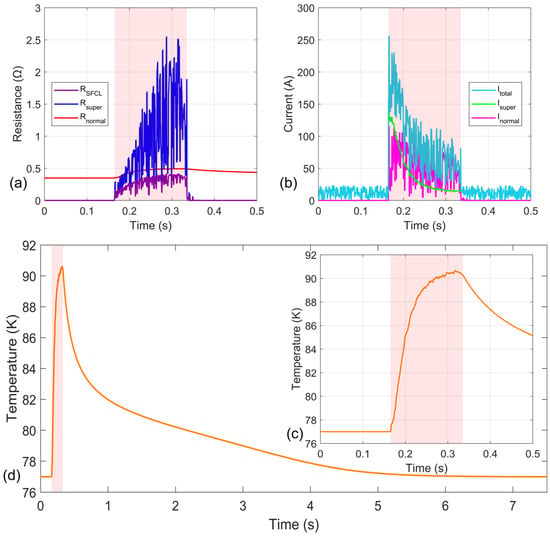
Figure 15.
Resistance, current, and temperature curves under transient disturbance: (a) resistance of each layer and total resistance of RSFCL; (b) current of each layer and total current of the line; (c) temperature rise process; (d) temperature drop process.
5. Conclusions
An integrated research and teaching platform for resistive-type superconducting fault current limiters has been studied in this paper. The platform can support various user-defined parameters and dynamic condition imports, providing a flexible tool for studying different superconducting materials and/or power grid fault scenarios. It adopts a modular and visual interactive design, effectively addressing the challenge of intuitively demonstrating the dynamic characteristics of RSFCL in traditional system. This platform provides strong support for the teaching and research of superconducting power engineering. Future work could further conduct a more in-depth study on the multi-layer conductor resistance modeling and internal temperature transfer properties inside the superconducting current limiting coil and then integrate the results with the dynamic liquid nitrogen cooling characteristics to achieve a more accurate equivalent model of the SFCL in various actual AC/DC power grid applications.
Author Contributions
Conceptualization, Q.Z., L.F. and X.C.; methodology, L.F. and S.G.; software, Q.Z. and S.G.; validation, L.F., M.T. and B.S.; writing—original draft preparation, Q.Z. and M.T.; writing—review and editing, L.F., J.B., X.C. and B.S.; supervision, X.C., L.F. and M.T.; project administration, X.C. and B.S. All authors have read and agreed to the published version of the manuscript.
Funding
This work was supported by the MOE (Ministry of Education in China) Thematic Case Project of China Academic Degrees and Graduate Education Development Center (ZT-2410636003), Sichuan Science and Technology Program (2025ZNSFSC0447), Sichuan Provincial Higher Education Teaching Reform Project (JG2024-0690, JSJ2024012), Teaching Reform Project of Sichuan Normal University (KFSY2023002), and the Fundamental Research Funds for the Central Universities.
Data Availability Statement
The data presented in this study are available on request from the corresponding author.
Conflicts of Interest
The authors declare no conflicts of interest.
References
- Alashqar, M.; Yang, C.; Xue, Y.; Liu, Z.; Zheng, W.; Zhang, X.-P. Enhancing transient stability of power systems using a resistive superconducting fault current limiter. Front. Energy Res. 2023, 10, 1106836. [Google Scholar] [CrossRef]
- Chen, Y.; Chen, X.; Fu, L.; Jiang, S.; Shen, B. Superconducting Hydrogen-electricity Multi-energy System for Transportation Hubs: Modeling, Technical Study and Economic-environmental Assessment. Appl. Appl. Energy 2025, 401, 126823. [Google Scholar] [CrossRef]
- Abou El-Ela, A.A.; El-Sehiemy, R.A.; Shaheen, A.M.; Ellien, A.R. Review on Active Distribution Networks with Fault Current Limiters and Renewable Energy Resources. Energies 2022, 15, 7648. [Google Scholar] [CrossRef]
- Bai, J.; Wu, X.; Chen, X.; Zhang, Z.; Fu, L.; Zhao, C.; Qing, K.; Luo, Q.; Gong, S.; Shen, B. Combined space cooling/heating and domestic hot water supply driven by data center waste heat: Complementary energy conservation, economic capacity optimization and generic analysis framework. Build. Environ. 2025, 283, 113402. [Google Scholar] [CrossRef]
- Luo, Z.Y. Research on Heat Transfer Characteristics of Resistive YBCO Superconducting DC Current Limiter in Quench and Recovery Processes. Ph.D. Thesis, Zhejiang University, Hangzhou, China, 2023. [Google Scholar]
- Li, B.; Wu, Q.; Li, C.; Ou, Y.; Zhu, J.; Chen, P.; Wei, D.; Xin, Y. A novel configuration approach of SFCLs in the power grid and its economic analysis. Int. J. Electr. Power Energy Syst. 2024, 155, 109483. [Google Scholar] [CrossRef]
- Li, W.; Sheng, J.; Qiu, D.; Cheng, J.; Ye, H.; Hong, Z. Numerical Study on Transient State of Inductive Fault Current Limiter Based on Field-Circuit Coupling Method. Materials 2019, 12, 2805. [Google Scholar] [CrossRef]
- Degtyarenko, P.N.; Zheltov, V.V.; Balashov, N.N.; Arkhangelsky, A.Y.; Degtyarenko, A.Y.; Kovalev, K.L. Fault Current Limitation in Electrical Power Networks Containing HTS Cable and HTS Fuse. Materials 2022, 15, 8754. [Google Scholar] [CrossRef]
- Li, M.; Chen, Y. An asymmetric stabilizer layer structure of REBCO superconducting tapes for resistive superconducting fault current limiters. Cryogenics 2024, 138, 103791. [Google Scholar] [CrossRef]
- Queiroz, A.T.; Bitencourt, A.A.; Nogueira, C.S.C.; Martins, F.G.R.; Fernando, J.M.D.; Polasek, A.; Sotelo, G.G. Development of a Hybrid Fault Current Limiter. IEEE Trans. Appl. Supercond. 2024, 34, 5601105. [Google Scholar] [CrossRef]
- Millán, J.S.; Millán, J.; Pérez, L.A.; Ruiz, H.S. Critical Current Density in d-Wave Hubbard Superconductors. Materials 2022, 15, 8969. [Google Scholar] [CrossRef]
- Pekarcíková, M.; Misík, J.; Drienovsky, M.; Krajcovic, J.; Vojenciak, M.; Búran, M.; Mosat, M.; Húlan, T.; Skarba, M.; Cuninková, E.; et al. Composite Heat Sink Material for Superconducting Tape in Fault Current Limiter Applications. Materials 2020, 13, 1832. [Google Scholar] [CrossRef]
- Hirsch, J.E. On Thermal and Electrodynamic Aspects of the Superconductive Transition Process. Materials 2024, 17, 254. [Google Scholar] [CrossRef]
- Kamali, A.; Barakati, S.M. Enhancing the performance of active mechanical circuit breakers in HVDC systems using a superconducting fault current limiter. Electr. Power Syst. Res. 2025, 247, 111727. [Google Scholar] [CrossRef]
- Kozak, J. Study on Recovery Time of Conduction-Cooled Resistive Superconducting Fault Current Limiter. Energies 2024, 17, 3350. [Google Scholar] [CrossRef]
- Skarba, M.; Pekarcíková, M.; Frolek, L.; Cuninková, E.; Necpal, M. Thermal Cycling of (RE)BCO-Based Superconducting Tapes Joined by Lead-Free Solders. Materials 2021, 14, 1052. [Google Scholar] [CrossRef] [PubMed]
- Li, W.; Xin, Y. Superconducting fault current limiter for multi-terminal HVDC grid protection. Superconductivity 2025, 15, 100195. [Google Scholar] [CrossRef]
- Yong, H.; Wei, D.; Tang, Y.; Liu, D. Numerical modelling of electromechanical coupling behaviors in HTS coil with implementation of H formulation in FE software. Superconductivity 2024, 10, 100097. [Google Scholar] [CrossRef]
- Shen, B.; Grilli, F.; Coombs, T. Overview of H-Formulation: A Versatile Tool for Modeling Electromagnetics in High-Temperature Superconductor Applications. IEEE Access 2020, 8, 100403–100414. [Google Scholar] [CrossRef]
- Fink, S.; Noe, M. High Voltage Calculations for a 380 kV Superconducting Fault Current Limiter. IEEE Trans. Appl. Supercond. 2024, 34, 5600705. [Google Scholar] [CrossRef]
- Yuan, J.; Ye, C.; Zhou, H.; Liu, J.; Zheng, Y.; Dong, W.; Ni, Z.; Wei, L. A Compact Saturated Core Fault Current Limiter Magnetically Integrated with Decoupling Windings. IEEE Trans. Power Deliv. 2023, 38, 2711–2723. [Google Scholar] [CrossRef]
- dos Santos, G.; Martins, F.G.R.; Sass, F.; Sotelo, G.G.; Morandi, A.; Grilli, F. A 3-D Finite-Element Method Approach for Analyzing Different Short Circuit Types in a Saturated Iron Core Fault Current Limiter. IEEE Trans. Appl. Supercond. 2022, 32, 5600713. [Google Scholar] [CrossRef]
- Zhang, Z.; Liu, C.; Gao, Y.; Suo, H.; Wang, L.; Chen, S.; Liu, J.; Wang, Q. A Tube Furnace Design for the Oxygen Annealing of a REBCO Superconducting Joint. Materials 2025, 18, 3053. [Google Scholar] [CrossRef] [PubMed]
- Cuninková, E.; Pekarcíková, M.; Skarba, M.; Krajcovic, J.; Pasák, M. Experimental and Numerical Analysis of High-Temperature Superconducting Tapes Modified by Composite Thermal Stabilization Subjected to Thermomechanical Loading. Materials 2021, 14, 3579. [Google Scholar] [CrossRef] [PubMed]
- Yan, S.; Ren, L.; Zhao, J.; Xu, Y.; Shen, S.; Xiong, Y.; Liu, B.; Xiao, F. Quenched Flux-Coupling Superconducting Fault Current Limiter Scheme and Its Electromagnetic Design Method. Materials 2023, 16, 754. [Google Scholar] [CrossRef] [PubMed]
- Nguyen, L.N.; Naud, M.; Weiss, J.; Pamidi, S.; Dönges, S.A.; van der Laan, D.; Nguyen, D.N. Simulation for the Fault Current Limiting Operation of REBCO CORC Superconducting Cables With Different Core Materials. IEEE Trans. Appl. Supercond. 2023, 33, 5600208. [Google Scholar] [CrossRef]
- Xiang, B.; Yuan, Z.; Li, L.; Yang, M.; Zhang, Q.; Liu, Z.; Geng, Y.; Wang, J. Electromagnetic Thermal Analysis on Variable Resistive-Type Superconducting Fault Current Limiter. IEEE Trans. Appl. Supercond. 2024, 34, 5602005. [Google Scholar] [CrossRef]
- Shen, B.; Chen, Y.; Li, C.; Wang, S.; Chen, X. Superconducting fault current limiter (SFCL): Experiment and the simulation from finite-element method (FEM) to power/energy system software. Energy 2021, 234, 121251. [Google Scholar] [CrossRef]
- Chen, X.; Gou, H.; Chen, Y.; Jiang, S.; Zhang, M.; Pang, Z.; Shen, B. Superconducting fault current limiter (SFCL) for a power electronic circuit: Experiment and numerical modelling. Supercond. Sci. Technol. 2022, 35, 045010. [Google Scholar] [CrossRef]
- Aurangzeb, M.; Xin, A.; Iqbal, S.; Jan, M.U. An Evaluation of Flux-Coupling Type SFCL Placement in Hybrid Grid System Based on Power Quality Risk Index. IEEE Access 2020, 8, 98800–98809. [Google Scholar] [CrossRef]
- Alafnan, H.; Yehia, D.M.; Albaker, A.; Alateeq, A. Comparing Copper With Stainless Steel as a Stabilizer Layer in Resistive Superconducting Fault Current Limiters. IEEE Access 2024, 12, 64385–64395. [Google Scholar] [CrossRef]
- Elsamahy, M. Reducing Microgrids Integration Complexity in Distribution Networks Considering Bidirectional Power Flow in SFCLs. IEEE Access 2022, 10, 80365–80378. [Google Scholar] [CrossRef]
- Lee, H.J.; Kim, J.S.; Kim, J.C.; Yun, S.Y.; Cho, S.M. Study on Operational Characteristics of Protection Relay with Fault Current Limiters in an LVDC System. Electronics 2020, 9, 322. [Google Scholar] [CrossRef]
- Chen, L.; He, H.; Li, G.; Chen, H.; Wang, L.; Chen, X.; Tian, X.; Xu, Y.; Ren, L.; Tang, Y. Study of Resistive-Type Superconducting Fault Current Limiters for a Hybrid High Voltage Direct Current System. Materials 2019, 12, 26. [Google Scholar] [CrossRef] [PubMed]
- de Sousa, W.T.B.; Näckel, O.; Noe, M. Transient Simulations of an Air-Coil SFCL. IEEE Trans. Appl. Supercond. 2014, 24, 5601807. [Google Scholar] [CrossRef]
- Xiao, H.; Qiu, J.; Wang, S.; Zhang, Q.; Gong, W.; Xin, Y.; Zhu, J.; Guo, Y. Analysis of Transient Overvoltage in 220 kV Saturated Core HTS FCL. IEEE Trans. Magn. 2011, 47, 2620–2623. [Google Scholar] [CrossRef]
- Ko, S.C.; Han, T.H.; Lim, S.H. Analysis on Double Quench and Instantaneous Power of SFCL Using Two Magnetically Coupled Windings According to Winding Direction. Energies 2020, 13, 5533. [Google Scholar] [CrossRef]
- Choi, S.-J.; Lim, S.-H. Directional Correction of Over-Current Relay Using Voltage Slope in Multi Terminal DC System With SFCL. IEEE Trans. Appl. Supercond. 2021, 31, 5602007. [Google Scholar] [CrossRef]
- Fabbri, M.; Morandi, A.; Negrini, F.; Ribani, P.L. Temperature dependent equivalent circuit of a magnetic-shield type SFCL. IEEE Trans. Appl. Supercond. 2005, 15, 2078–2081. [Google Scholar] [CrossRef]
- Yan, D.D.; Sadeghi, A.; Yazdani-Asrami, M.; Song, W.J. Artificial-Intelligence-Driven Model for Resistive Superconducting Fault Current Limiter in Future Electric Aircraft. IEEE Trans. Appl. Supercond. 2024, 34, 5601616. [Google Scholar] [CrossRef]
- Alafnan, H.; Pei, X.Z.; Mansour, D.E.A.; Khedr, M.; Song, W.J.; Alsaleh, I.; Albaker, A.; Alturki, M.; Zeng, X.W. Impact of Copper Stabilizer Thickness on SFCL Performance with PV-Based DC Systems Using a Multilayer Thermoelectric Model. Sustainability 2023, 15, 7372. [Google Scholar] [CrossRef]
- de Sousa, W.T.B.; Polasek, A.; Dias, R.; Matt, C.F.T.; de Andrade, R. Thermal-electrical analogy for simulations of superconducting fault current limiters. Cryogenics 2014, 62, 97–109. [Google Scholar] [CrossRef]
- Chen, W.; Song, P.; Jiang, H.; Zhu, J.; Zou, S.; Qu, T. Investigations on Quench Recovery Characteristics of High-Temperature Superconducting Coated Conductors for Superconducting Fault Current Limiters. Electronics 2021, 10, 259. [Google Scholar] [CrossRef]
- Yehia, D.M.; Taha, I.B.M. Application of Superconducting Fault Current Limiter as a Virtual Inertia for DC Distribution Systems. IEEE Access 2021, 9, 135384–135391. [Google Scholar] [CrossRef]
- Li, D.J.; Xiang, B.; Yao, C.W.; Zhang, Q.; Pang, X.F.; Sun, W.X.; Tang, H.Y.; Zhang, X.; Yuan, Z.B.; Cai, L.L. Influence of Shunt Branch on the Current Limiting and Recovery Performance of Variable Resistance SFCL. IEEE Access 2025, 13, 418–427. [Google Scholar] [CrossRef]
- Yang, Z.; Song, P.; Feng, F.; Qu, T. Critical current degradation of REBCO coated conductor tapes caused by multiple cracks under tensile loading. Superconductivity 2025, 15, 100185. [Google Scholar] [CrossRef]
- Xie, Q.; Chen, X.; Chen, Y.; Gou, H.; Jiang, S.; Xu, H.; Hu, S. Superconductor-circuit-temperature coupled simulation of a fault-tolerant boost converter employing superconducting fault current limiter. IEEE Trans. Appl. Supercond. 2021, 31, 1–5. [Google Scholar] [CrossRef]
- Hong, J.P. Study on Boiling Heat Transfer Coefficient in Liquid Nitrogen Bath by Inverse Heat Conduction Method; Zhejiang University: Hangzhou, China, 2008. [Google Scholar]
- Luo, X.; Ma, J.; Xiao, H.; Zhang, Z.; Yuan, C. Multiphysics multilayer modelling and simulation of HTS REBCO magnets carrying direct currents under AC magnetic fields. Superconductivity 2025, 14, 100157. [Google Scholar] [CrossRef]
- Wang, Y.; Fang, J.; Haugan, T.; Badcock, R.A.; Storey, J.G.; Jiang, Z. Numerical simulations on the AC loss of REBCO stacks under rotating magnetic fields. Superconductivity 2024, 11, 100111. [Google Scholar] [CrossRef]
Disclaimer/Publisher’s Note: The statements, opinions and data contained in all publications are solely those of the individual author(s) and contributor(s) and not of MDPI and/or the editor(s). MDPI and/or the editor(s) disclaim responsibility for any injury to people or property resulting from any ideas, methods, instructions or products referred to in the content. |
© 2025 by the authors. Licensee MDPI, Basel, Switzerland. This article is an open access article distributed under the terms and conditions of the Creative Commons Attribution (CC BY) license (https://creativecommons.org/licenses/by/4.0/).